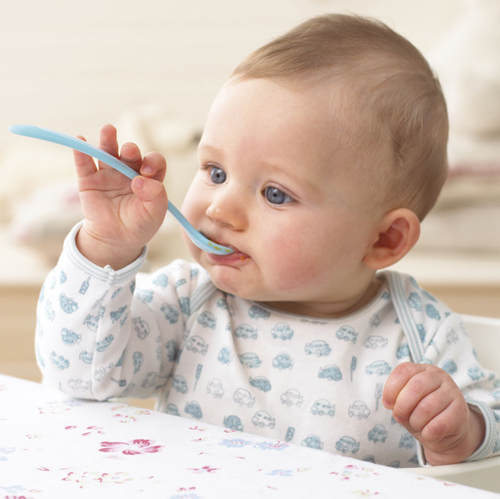Every baby is different,
both in the way they approach mealtimes and in their individual tastes.
There is plenty to consider when you begin weaning, but try to relax as you introduce your little one to solid foods, and choose amongst these tried-and-tested solutions for the hurdles you might encounter.
| Q: |
Where is the best place to feed my baby?
| | A: |
At first, you may want to feed your baby in her bouncer or even
on your lap. As soon as she is able to sit up, it’s a good idea to feed
her in a highchair in the kitchen, at or by the kitchen table. She’ll
become used to the concept that people sit down for a meal (hopefully
together, as well!), and at a table. Your little one will also
understand that when she sits down in her highchair, it’s meal time, and
not playtime or anything else. She’s more likely to concentrate on
eating, if this is what she expects. It will also save you a great deal
of hassle in the future if she always eats her meals in the same place,
because she will understand that dinner in front of the television is
not an option.
Finally, it goes
without saying that kitchens are much easier than sitting rooms to clean
up after your baby has created her usual mess!
|
| Q: |
How often does my baby need to eat solids during the first few weeks?
| | A: |
Begin by offering solids once a day, around a normal “meal time.”
Midday is a good time to start, as most little ones won’t be too tired,
and therefore more willing to try new things. This will also give your
baby time to digest the new food, and not struggle with gas during the
night. Don’t wait until your baby is starving, because he’ll want only
one thing—his usual milk! Over the next month or so, you can increase
the number of solid food meals.
|
| Q: |
When should my baby be eating three meals a day?
| | A: |
By the age of seven, eight, or nine months your baby should be
eating three meals a day, and be ready to enjoy a wide variety of
tastes. She should have doubled her birth weight, and a diet of milk may
not be enough for her, so it’s important to give her red meat, which is
a good source of iron and zinc, and oily fish, such as salmon or tuna,
which contain essential fatty acids that are important for your baby’s
brain development. Don’t give your baby more than two portions of oily
fish a week.
|
| Q: |
When do babies feed themselves?
| | A: |
This won’t happen for a little while. At around the age of ten or
eleven months, babies often refuse to be spoon fed and prefer to feed
themselves. The more you encourage your baby to feed himself, the more
proficient he will become—encourage him to pick up finger foods, and to
have a small spoon or fork from his first days of weaning. He may use
his hands to eat for many months to come, and this is to be encouraged
as well, as babies learn to explore food in this way, and learn about
textures and consistencies, and he’ll be more likely to try things that
he may reject when you offer it on a spoon.
|
| Q: |
My baby flings her plate across the room, and wipes her hands everywhere; how can I discourage her?
| | A: |
A little mess is to be expected, and it’s important to allow
babies to investigate solid foods with their hands—it is a perfectly
normal part of development, and helps them master the art of finger
feeding, which leads to self-feeding. Throwing a plate is probably not
intentional, but another experiment! You can also make life easier by
investing in a bowl that sticks to her tray with a suction cup.
|
| Q: |
How much food does my baby need?
| | A: |
Your baby needs only a little food at the outset—perhaps a
tablespoon or two of purée. After you have introduced a number of
different foods, you can start blending together purées, and offering
fruits, vegetables, as well as meat and fish, and whole grains or
pulses, such as rice, and pasta, at the same meal. You are offering him
variety and new tastes at first, which will build up to form the basis
of a healthy meal. Your baby will also let you know whether what you are
providing is enough.
|
| Q: |
Should I avoid feeding my baby too close to bedtime?
| | A: |
In the early days, it is a good idea to avoid feeding your baby
too late, as some babies struggle to digest their foods at first. Give
her main “meal” at lunchtime, and then something gentle and nourishing
in the evening, such as cheesy mashed potatoes with broccoli.
|
Did you know…
that you can introduce
age-appropriate cutlery to your baby from the outset? Choose soft
plastic implements with no sharp edges or points, and which fit neatly
in his little hand. Most babies do not develop the skills necessary to
feed themselves using cutlery until much later—at the age of two or
three, and sometimes even later. That isn’t to say, however, that they
cannot attempt to do so. It’s a good idea to encourage him to try, as
you feed him alongside.

|